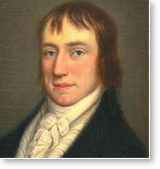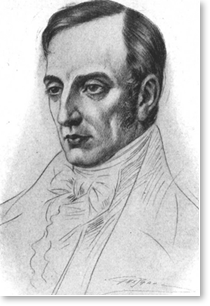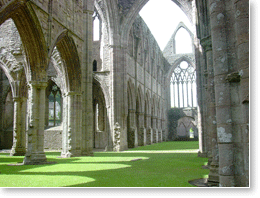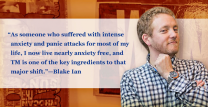
William Wordsworth
1770–1850 • ENGLAND
ON A FRESH MORNING IN EARLY JULY, a 28-year-old man sets out on foot from his home on the southwest coast of England. A writer, he loves walking, traversing the countryside for days at a time. On this excursion, he and his sister are heading up the scenic Wye River Valley, just across the border in Wales, with its many low, forest-blanketed hills.
When they enter the valley, they climb the banks of the river. A few miles below, beside the river, they can see the ruins of Tintern Abbey, built five centuries earlier, now a stone latticework open to wind and sky. As his sister walks ahead, he sits down on the grass among the trees and closes his eyes.
 Then the experience comes. He has had it before — and it’s the experience he lives for. Had his sister seen him, she might have thought he was just resting. Deep within, however, he feels something changing. He settles into a state of inner quietness, beyond thought, beyond feeling — simple, natural, yet profound. In a few minutes, it’s over. He opens his eyes, stands up, and walks back down the hill, resuming his tour.
Then the experience comes. He has had it before — and it’s the experience he lives for. Had his sister seen him, she might have thought he was just resting. Deep within, however, he feels something changing. He settles into a state of inner quietness, beyond thought, beyond feeling — simple, natural, yet profound. In a few minutes, it’s over. He opens his eyes, stands up, and walks back down the hill, resuming his tour.
As he crosses the river, words begin taking shape in his mind. The words keep coming until he returns home several days later. There he finally has a chance to set the words down on paper — a poem, nearly one hundred sixty lines. He does not change a single one. “No poem of mine,” he comments later, “was composed under circumstances more pleasant for me to remember than this.” [1] In the poem he describes:
That blessed mood,
In which the burthen of the mystery,
In which the heavy and the weary weight
Of all this unintelligible world,
Is lightened: — that serene and blessed mood,
In which the affections gently lead us on —
Until, the breath of this corporeal frame
And even the motion of our human blood
Almost suspended, we are laid asleep
In body, and become a living soul;
While with an eye made quiet by the power
Of harmony, and the deep power of joy,
We see into the life of things. [2]
The young man is William Wordsworth. The year is 1798. His poem, “Lines Composed a Few Miles Above Tintern Abbey,” was published later that same year in Lyrical Ballads, which also included several poems by his friend Samuel Taylor Coleridge — and which launched the English Romantic movement in literature, altering the course of English literature and poetry.
What was he experiencing?
Wordsworth’s experience lasted only a few minutes, but his words have been admired for two centuries. What was he experiencing?
 His description is remarkable for its exactness. He settles into a state of increasing tranquility. The “weary weight” of the “unintelligible world” grows lighter and eventually fades away. Describing the unique condition of his body, he tells us he feels deeply rested. His breath and even his blood flow seem “almost suspended,” and he feels as if “laid asleep in body.”
His description is remarkable for its exactness. He settles into a state of increasing tranquility. The “weary weight” of the “unintelligible world” grows lighter and eventually fades away. Describing the unique condition of his body, he tells us he feels deeply rested. His breath and even his blood flow seem “almost suspended,” and he feels as if “laid asleep in body.”
But is he asleep? On the contrary, he seems more awake than ever. He feels he has “become a living soul” — as though in his prior state he had not been fully alive. From this deep level he is able to “see into the life of things.”
Clearly this is more than a moment of relaxation — it is a unique mode of knowledge. From deep within, he experiences “harmony, and the deep power of joy.” In all, he feels “blessed.”
Wordsworth was known to be of good health and sound mind, not given to far-out fancy. By every indication, he is trying to describe a concrete experience as precisely as he can. His body is deeply relaxed, his mind profoundly settled and awake within itself.
This was not an isolated experience for Wordsworth. He had many such moments. They affected him powerfully. He found them physically and mentally revitalizing and believed they helped make him the great poet he was. And he celebrates them everywhere in his poetry, to the extent that the term Wordsworthian experience is sometimes used to refer to experiences of this type.
Yet Wordsworth speaks of we, us, and our, implying this is a universal experience, one for all humanity. Indeed, he offers us an excellent description of a whole category of experience that people have reported throughout history and around the world.
A fourth major state of consciousness
 Wordsworth seems to have experienced a state of consciousness that is simple and natural yet uniquely different from the familiar states of waking, dreaming, and sleeping. In fact, it is a fourth major state of consciousness. Maharishi calls this state Transcendental Consciousness. In restfully alert state, mental activity has settled down, like waves settling on the ocean, leaving the experience of consciousness in its most silent, wakeful state — unbounded awareness. At the same time, physiological activity spontaneously settles down and one experiences a state of deep relaxation that enables the body to dissolve stress with exceptional efficiency.
Wordsworth seems to have experienced a state of consciousness that is simple and natural yet uniquely different from the familiar states of waking, dreaming, and sleeping. In fact, it is a fourth major state of consciousness. Maharishi calls this state Transcendental Consciousness. In restfully alert state, mental activity has settled down, like waves settling on the ocean, leaving the experience of consciousness in its most silent, wakeful state — unbounded awareness. At the same time, physiological activity spontaneously settles down and one experiences a state of deep relaxation that enables the body to dissolve stress with exceptional efficiency.
Maharishi also provided a simple, natural, effortless technique by which anyone could have this experience on a regular basis — 20 minutes twice each day, in fact. This is the Transcendental Meditation technique, which has now been learned by millions of people around the world, of all ages, cultural backgrounds, and walks of life.
A flood tide of scientific research — a broad spectrum of benefits
Maharishi vigorously encouraged scientific research on the Transcendental Meditation technique and on the fourth state of consciousness it so effortlessly elicits. Since the first studies in the late 1960s, there has been a flood tide of research. Some 650 studies have been conducted to date, at 250 universities and research institutes in 33 countries, by researchers in such fields as physiology, biochemistry, neuroscience, psychology, medicine, sociology, and criminology. The results have been published in 150 leading scientific and scholarly journals.
 The U.S. National Institutes of Health has invested more than $25 million in research on the Transcendental Meditation program, particularly on such beneficial effects for cardiovascular health as reducing high blood pressure. The technique is widely prescribed by doctors and is also used in a growing number of schools across the U.S. and worldwide to reduce stress, promote learning ability, and develop full creative potential.
The U.S. National Institutes of Health has invested more than $25 million in research on the Transcendental Meditation program, particularly on such beneficial effects for cardiovascular health as reducing high blood pressure. The technique is widely prescribed by doctors and is also used in a growing number of schools across the U.S. and worldwide to reduce stress, promote learning ability, and develop full creative potential.
What has this research found? With regular, twice-daily experience of this fourth state of consciousness, every facet of life is enriched. Intelligence and creativity increase, health improves, one’s personality develops, personal relationships are enriched. When even 1% of the population of a city has learned the Transcendental Meditation technique, the quality of life for the whole city improves, reflected in reduced crime rate and other measures.
Maharishi compares the experience of Transcendental Consciousness to watering the root of a tree. Just as watering the root nourishes all the branches of the tree in a single stroke, so too the experience of transcending nourishes every branch of life.
Available to everyone
And though Wordsworth may not have been aware of it, this state forms the portal to still higher states of consciousness — higher modes of knowledge, power, and fulfillment. Wordsworth describes for us the gateway into those higher worlds. And Maharishi has described the nature of these higher states in fine detail.
 “Tintern Abbey” has appeared in countless anthologies. It has been required reading in college classes decade after decade. These lines in particular have been singled out in numberless essays. Yet few readers have suspected what Wordsworth is really describing.
“Tintern Abbey” has appeared in countless anthologies. It has been required reading in college classes decade after decade. These lines in particular have been singled out in numberless essays. Yet few readers have suspected what Wordsworth is really describing.
Now we know. We also know that this extraordinary — and extraordinarily natural — experience need not be left to chance. Nor is it restricted to Romantic poets — it is now available to everyone.
REFERENCES
[1] William Wordsworth, S.T. Coleridge, Lyrical Ballads 1798, London: Duckworth, 1898, 252 (Notes: W.W. 1843).
[2] William Wordsworth, Lyrical Ballads (London, Bristol: Biggs and Cottle, for T.N. Longman, Paternoster-Row, 1798), 203-204.
————————————————-
 Dr. Craig Pearson is Executive Vice-President of Maharishi University of Management in Fairfield, Iowa. He has served the University in a variety of roles over the past 33 years, including Dean of Faculty, Dean of Students, Director of Maharishi University of Management Press, Director of Freshman Composition, and Professor of Professional Writing.
Dr. Craig Pearson is Executive Vice-President of Maharishi University of Management in Fairfield, Iowa. He has served the University in a variety of roles over the past 33 years, including Dean of Faculty, Dean of Students, Director of Maharishi University of Management Press, Director of Freshman Composition, and Professor of Professional Writing.
He holds a PhD in Maharishi Vedic Science from MUM and is the author of two books on the development of full human potential, The Complete Book of Yogic Flying and The Supreme Awakening: Developing the Infinite Potential Within (forthcoming). He is also a member of the Board of Directors of Maharishi School of the Age of Enlightenment.



